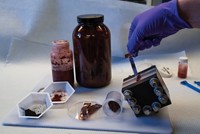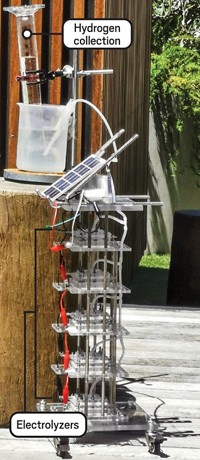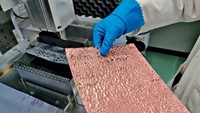Advertisement
Grab your lab coat. Let's get started
Welcome!
Welcome!
Create an account below to get 6 C&EN articles per month, receive newsletters and more - all free.
It seems this is your first time logging in online. Please enter the following information to continue.
As an ACS member you automatically get access to this site. All we need is few more details to create your reading experience.
Not you? Sign in with a different account.
Not you? Sign in with a different account.
ERROR 1
ERROR 1
ERROR 2
ERROR 2
ERROR 2
ERROR 2
ERROR 2
Password and Confirm password must match.
If you have an ACS member number, please enter it here so we can link this account to your membership. (optional)
ERROR 2
ACS values your privacy. By submitting your information, you are gaining access to C&EN and subscribing to our weekly newsletter. We use the information you provide to make your reading experience better, and we will never sell your data to third party members.
Hydrogen Power
New recipe for green hydrogen mixes aluminum and caffeine in saltwater
Researchers are working towards a cheap, sustainable way to split water using aluminum
by Prachi Patel
July 31, 2024
Put aluminum powder in water, and it reacts vigorously, freeing hydrogen gas and producing metal hydroxide and heat. Researchers are now getting closer to a low-cost, sustainable way of usingthis reaction to produce green hydrogen fuel (Cell Rep. Phys. Sci. 2024, DOI: 10.1016/j.xcrp.2024.102121).
The aluminum–water reaction splits water without using electricity. Interest in making the reaction practical for the hydrogen economy first took off in the 1970s. The challenge is that aluminum instantly forms a protective aluminum oxide skin in air that keeps it from reacting with water. “This is why when you put a soda can in water it doesn’t react,” says Aly Kombargi, a mechanical engineering PhD student at the Massachusetts Institute of Technology.
In 2018, MIT researchers found that coating aluminum pellets with a liquid metal alloy of gallium and indium perforates the oxide skin, creating channels for water to reach the aluminum interior. The pellets reacted with water, consuming the aluminum and giving a nearly 100% hydrogen yield. But the expensive alloy broke down during the reaction.
Kombargi and colleagues have now discovered a way to recover the alloy for reuse to cut costs and waste. They put the pellets of coated aluminum in saltwater instead of freshwater. Sodium ions in saltwater form a barrier around the alloy as the aluminum is consumed, keeping over 90% of the alloy intact for the researchers to scoop out.
Alas, the salt ions slowed down the aluminum–water reaction. But the researchers were able to speed things up with a caffeine jolt. When they added imidazole, a key part of caffeine, to the water, the reaction time went down to 10 minutes compared to two hours without the addition.
Kombargi says he is now using aluminum from used soda cans. The team is developing a reactor based on the process that could use seawater to make hydrogen fuel for powering boats or underwater vehicles.
“This is really exciting work,” says Keena Trowell, a mechanical engineer at McGill University. Improving alloy recovery and reaction rate are huge steps towards practicality, she says, and finding ways to use the heat produced by the reaction could further boost efficiency.





Join the conversation
Contact the reporter
Submit a Letter to the Editor for publication
Engage with us on Twitter